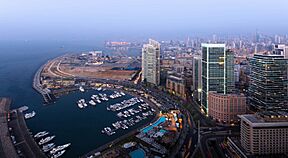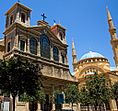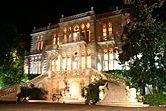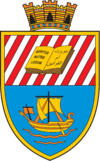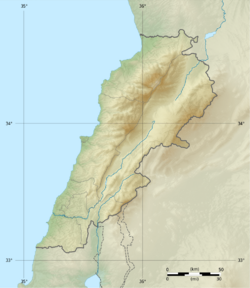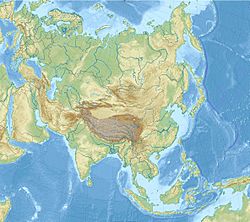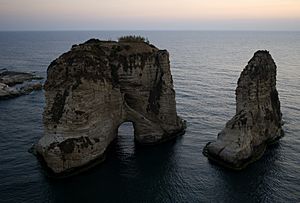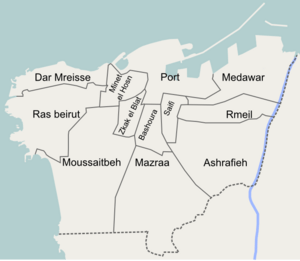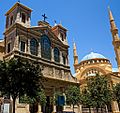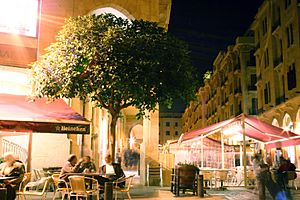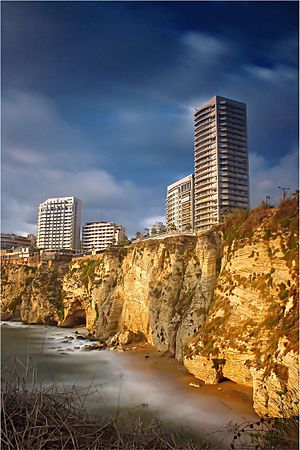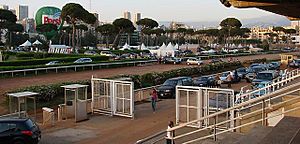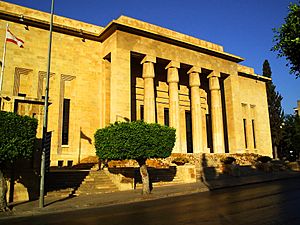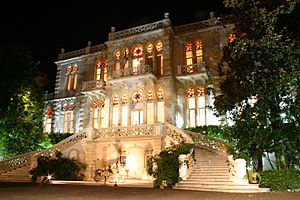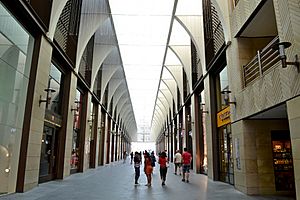Beirut facts for kids
Quick facts for kids
Beirut
بيروت
|
|||
|---|---|---|---|
|
Left to right from top: Beirut Zaitunay Bay; Sahat al Shouhada; The Clock Tower in Nejmeh Square, Beirut; Maronite Cathedral of Saint George (left) and Mohammad Al-Amin Mosque (right); Sursock Museum; and Pigeon Rocks of Raouché
|
|||
|
|||
| Nickname(s):
Paris of the East
|
|||
| Motto(s):
Berytus Nutrix Legum (Latin)
Beirut, mother of laws |
|||
| Country | |||
| Governorate | Beirut | ||
| Area | |||
| • Capital city and municipality | 67 km2 (26 sq mi) | ||
| Population
(2017)
|
|||
| • Capital city and municipality | c. 433,249 | ||
| • Density | 6,400/km2 (17,000/sq mi) | ||
| • Metro | c. 2,145,527 | ||
| Demonym(s) | Beiruti | ||
| Time zone | UTC+2 (EET) | ||
| • Summer (DST) | UTC+3 (EEST) | ||
| Area code(s) | +961 (01) | ||
| ISO 3166 code | LB-BA | ||
| Patron Saint | Saint George | ||
Beirut is the capital and largest city of Lebanon. It's located on a peninsula along Lebanon's Mediterranean coast. Around 2.5 million people live in the greater Beirut area. The city has been lived in for over 5,000 years, making it one of the oldest cities in the world.
Beirut is where Lebanon's government is based. It's also very important for the country's economy, with many banks and businesses. The seaport is a key trading hub for Lebanon and the surrounding region. Beirut has faced tough times, including the Lebanese Civil War, the 2006 Lebanon War, and a huge explosion in 2020. Despite these challenges, the city is always working to rebuild and grow.
Contents
What's in a Name?
The name Beirut comes from the Arabic word Bayrūt. This name comes from an older Phoenician word, bēʾrūt, which means "wells." This makes sense because the area had a lot of easily reachable underground water.
Ancient Greeks called the city Bērytós, and the Romans later called it Berytus. When it became a Roman colony, its full name was Colonia Iulia Augusta Felix Berytus. During the crusades, it was known as Barut or Baruth.
Beirut Through Time
Beirut has a very long history. People first settled here over 5,000 years ago. Digs in the city center have found remains from many different ancient groups, like the Phoenicians, Romans, and Ottomans.
Early Settlements
Long before Beirut became a city, people lived in the area. Archaeologists have found ancient tools made of flint from different time periods, showing that humans were here tens of thousands of years ago. These tools help us understand how early people lived and hunted.
Phoenician Times
The Phoenician port of Beirut was a busy place for trade. It was located on the northern coast. The Phoenicians were skilled sailors and traders, and Beirut was an important part of their network.
Greek and Roman Influence
Around 140 BC, the Phoenician city was destroyed. Later, the Greeks rebuilt it. In 64 BC, the Romans took over and brought back the name Berytus. The city became a Roman colony and was very important.
Beirut was known for its famous law school. Two of Rome's most famous legal experts, Papinian and Ulpian, taught there. This school was so important that in 533 AD, the emperor Justinian recognized it as one of the empire's three official law schools.
However, in 551 AD, a huge earthquake hit Berytus. It caused a lot of damage and killed many people. Because of this, the law school had to move.
Middle Ages
In 635 AD, Muslims conquered Beirut. For a while, during the crusades, the city was part of the Kingdom of Jerusalem. It was an important trading center. In 1291, the Mamluk army took over Beirut, and the Crusaders left.
Ottoman Rule
The Ottoman Empire conquered Lebanon, including Beirut, in the early 1500s. Beirut grew into a major port and trading center, especially with European countries like France. This trade helped families like the Sursocks become very rich.
During this time, many Christian refugees came to Beirut from other parts of Lebanon, changing the city's population. In 1888, Beirut became the capital of a larger region called a vilayet. It became a diverse city with strong connections to Europe and the United States. Educational places like the American University of Beirut were founded here.
Beirut Today
After World War I, Beirut was under French control. Lebanon became independent in 1943, and Beirut became its capital. The city became a popular place for tourists and a banking hub, especially during the oil boom in the Persian Gulf.
This time of growth ended in 1975 when the Lebanese Civil War began. Beirut was divided into a Muslim west and a Christian east. Many people left the country, and much of the city was destroyed. The war lasted until 1990.
Since the war ended, people have been rebuilding Beirut. The city has slowly regained its status as a cultural and business center in the Middle East. However, in 2020, a huge explosion at the Port of Beirut caused a lot of damage and left many people homeless. This led to protests and changes in the government.
Beirut's Location and Weather
Beirut is on a peninsula that sticks out into the Mediterranean Sea. It's surrounded by the Lebanon Mountains. The city has a triangular shape, built on two hills: Al-Ashrafieh and Al-Musaytibah. The coast has different types of areas, from rocky beaches to sandy shores and cliffs.
Climate
Beirut has a hot-summer Mediterranean climate. This means it has mild days and nights because the sea helps keep temperatures steady. Autumn and spring are warm but short. Winters are mild and rainy, and it almost never snows. Summers are long, hot, and humid. Most of the rain falls from October to April.
| Climate data for Beirut International Airport | |||||||||||||
|---|---|---|---|---|---|---|---|---|---|---|---|---|---|
| Month | Jan | Feb | Mar | Apr | May | Jun | Jul | Aug | Sep | Oct | Nov | Dec | Year |
| Record high °C (°F) | 27.9 (82.2) |
30.5 (86.9) |
36.6 (97.9) |
39.3 (102.7) |
39.0 (102.2) |
40.0 (104.0) |
40.4 (104.7) |
39.5 (103.1) |
37.5 (99.5) |
37.0 (98.6) |
33.1 (91.6) |
30.0 (86.0) |
40.4 (104.7) |
| Mean daily maximum °C (°F) | 17.4 (63.3) |
17.5 (63.5) |
19.6 (67.3) |
22.6 (72.7) |
25.4 (77.7) |
27.9 (82.2) |
30.0 (86.0) |
30.7 (87.3) |
29.8 (85.6) |
27.5 (81.5) |
23.2 (73.8) |
19.4 (66.9) |
24.3 (75.7) |
| Daily mean °C (°F) | 14.0 (57.2) |
14.0 (57.2) |
16.0 (60.8) |
18.7 (65.7) |
21.7 (71.1) |
24.9 (76.8) |
27.1 (80.8) |
27.8 (82.0) |
26.8 (80.2) |
24.1 (75.4) |
19.5 (67.1) |
15.8 (60.4) |
20.9 (69.6) |
| Mean daily minimum °C (°F) | 11.2 (52.2) |
11.0 (51.8) |
12.6 (54.7) |
15.2 (59.4) |
18.2 (64.8) |
21.6 (70.9) |
24.0 (75.2) |
24.8 (76.6) |
23.7 (74.7) |
21.0 (69.8) |
16.3 (61.3) |
12.9 (55.2) |
17.7 (63.9) |
| Record low °C (°F) | 0.8 (33.4) |
3.0 (37.4) |
0.2 (32.4) |
7.6 (45.7) |
10.0 (50.0) |
15.0 (59.0) |
18.0 (64.4) |
19.0 (66.2) |
17.0 (62.6) |
11.1 (52.0) |
7.0 (44.6) |
4.6 (40.3) |
0.2 (32.4) |
| Average precipitation mm (inches) | 154 (6.1) |
127 (5.0) |
84 (3.3) |
31 (1.2) |
11 (0.4) |
1 (0.0) |
0.3 (0.01) |
0 (0) |
5 (0.2) |
60 (2.4) |
115 (4.5) |
141 (5.6) |
730 (28.7) |
| Average rainy days | 12 | 10 | 8 | 5 | 2 | 2 | 0.04 | 0.1 | 1 | 4 | 7 | 11 | 62 |
| Average relative humidity (%) | 64 | 64 | 64 | 66 | 70 | 71 | 72 | 71 | 65 | 62 | 60 | 63 | 66 |
| Average dew point °C (°F) | 7 (45) |
8 (46) |
9 (48) |
12 (54) |
16 (61) |
19 (66) |
22 (72) |
22 (72) |
19 (66) |
16 (61) |
11 (52) |
8 (46) |
14 (57) |
| Mean monthly sunshine hours | 131 | 143 | 191 | 243 | 310 | 348 | 360 | 334 | 288 | 245 | 200 | 147 | 2,940 |
| Source 1: Danish Meteorological Institute (sun 1931–1960) | |||||||||||||
| Source 2: Time and Date (dewpoints, between 1985-2015) | |||||||||||||
| Jan | Feb | Mar | Apr | May | Jun | Jul | Aug | Sep | Oct | Nov | Dec |
|---|---|---|---|---|---|---|---|---|---|---|---|
| 18.5 °C (65.3 °F) | 17.5 °C (63.5 °F) | 17.5 °C (63.5 °F) | 18.5 °C (65.3 °F) | 21.3 °C (70.3 °F) | 24.9 °C (76.8 °F) | 27.5 °C (81.5 °F) | 28.5 °C (83.3 °F) | 28.1 °C (82.6 °F) | 26.0 °C (78.8 °F) | 22.6 °C (72.7 °F) | 20.1 °C (68.2 °F) |
City Areas
Beirut is divided into 12 main areas called quarters. These are:
- Achrafieh
- Dar Mreisse
- Bachoura
- Mazraa (with the neighborhood Badaro)
- Medawar (with the neighborhood Mar Mikhaël)
- Minet El Hosn
- Moussaitbeh (with Ramlet al-Baida)
- Port
- Ras Beirut
- Rmeil
- Saifi
- Zuqaq al-Blat
Badaro is a cool, artistic neighborhood with a lively nightlife. It's near the Beirut Hippodrome and the Beirut Pine Forest.
There are also Palestinian refugee camps in and around Beirut, like Bourj el-Barajneh, Shatila, and Mar Elias.
Who Lives in Beirut?
Lebanon hasn't had a full population count since 1932. But it's estimated that Beirut and its greater area have about 2.2 million people.
Religions in Beirut
Religion in Beirut (2018 Elections results) Islam (60%) Christianity (37.4%) Druze (1.1%) Judaism (0.9%) Other (0.6%)
Beirut is a very diverse city with many different religions. Before the civil war, people of different faiths lived side-by-side. After the war, some areas became more separated by religion. East Beirut is mostly Christian, while West Beirut is mostly Sunni Muslim, with smaller groups of Shia, Christians, and Druze. However, people are now starting to move back into mixed areas.
-
Maghen Abraham Synagogue in Downtown Beirut
Beirut Central District
The Beirut Central District (BCD), also called Centre Ville, is the historic heart of Beirut. It's a busy area for business, finance, culture, and fun. After the civil war, this area was rebuilt to bring back its important role in the region.
The BCD has many gardens, squares, and open spaces. It's a great place for shopping, eating, and entertainment. There are over 100 cafes, restaurants, and nightclubs. The Beirut Souks are old markets that have been renovated, with over 200 stores.
Beirut's Economy
Beirut's economy mainly focuses on services, especially banking and tourism. The city is a major financial center for the Arab world. Many banks and corporations are based here.
Banking and Finance
Beirut's banking system is very strong. It helps protect foreign money and earnings. You can easily exchange Lebanese money for other currencies. There are no limits on moving money in and out of Lebanon. This makes Beirut an attractive place for financial business.
Tourism in Beirut
Tourism has always been important for Beirut's economy. Before the civil war, Beirut was known as the "Paris of the Middle East" because it was a popular and beautiful city. After the war, the city worked hard to rebuild its tourism industry.
The Beirut Central District is a key tourist spot. It has old stone buildings, arcaded streets, and a mix of French, Venetian, and Arab architecture. You can find old mosques, churches, and Roman ruins here. There are also many restaurants, cafes, and shops.
Another popular place is the Corniche Beirut, a long walkway along the sea. It's a great place to stroll and see the famous Pigeon Rocks of Raouché.
Badaro is a charming neighborhood with a relaxed feel. It has many small shops, cafes, and restaurants. It's a favorite spot for locals and visitors alike.
Hamra Street is a busy street with lots of shops, restaurants, and cafes. It's close to the American University of Beirut, so it's popular with students.
Gemmayzeh is Beirut's artistic area, with narrow streets and historic buildings. It's known for its trendy bars, pubs, and cafes. However, Gemmayzeh was heavily damaged in the 2020 Beirut explosion.
Beirut has been recognized as one of the best cities in the world for tourism. It was even named the top place to visit by The New York Times in 2009.
Learning in Beirut

Beirut has many universities, colleges, and technical schools. The American University of Beirut (AUB), founded in 1866, is one of the oldest English-speaking universities in the region. The Université Saint-Joseph (USJ), founded in 1875, is the oldest French-speaking university.
Other universities include the Lebanese University (the only public one), Lebanese American University (LAU), and Beirut Arab University (BAU). There are also many private high schools in the city.
-
Saint Joseph University, or Université Saint-Joseph, founded by the Jesuits in 1875
-
Haigazian University was founded in 1955 by the Armenian Evangelical community.
Getting Around Beirut
Beirut's main airport is the Beirut–Rafic Hariri International Airport, located in the southern suburbs. The Port of Beirut is a large and important seaport. You can also reach Beirut by road from Damascus, Syria.
The city has many bus connections to other cities in Lebanon and Syria. There are public buses and private bus companies. In 2017, Beirut also started a bike-sharing service in some areas.
Beirut's Culture and Fun
Beirut's culture has been shaped by many different groups, including Greeks, Romans, Arabs, Ottomans, and French. The city's law school was one of the earliest and most important in the ancient world.
Beirut has hosted many international events, like the Francophonie and Arab League summits. In 2009, UNESCO named it the World Book Capital.
Beirut is also known for its lively nightlife. Streets like Rue Monnot and Rue Gouraud in Gemmayze and Mar Mikhael are popular spots for bars and clubs.
Museums to Explore
- The National Museum of Beirut is the main archaeology museum in Lebanon. It has about 1,300 items from prehistoric times to the medieval period.
- The Archaeological Museum of the American University of Beirut is one of the oldest museums in the Middle East, with many artifacts from Lebanon and nearby countries.
- Sursock Museum is a beautiful art museum that used to be a private villa. It shows Japanese art, Islamic art, and Italian paintings.
- The Robert Mouawad Private Museum has a collection of ancient artifacts and antiques.
- Planet Discovery is a science museum for children with interactive exhibits.
- The Museum of Lebanese Prehistory shows bones, stone tools, and pottery from ancient times.
- In 2013, the Mim Museum, a private mineral museum, opened. It has about 2,000 minerals from over 70 countries. It even has a fossil of a pterodactyl found in Lebanon!
Sports in Beirut
Beirut has hosted many major sports events, including the Mediterranean Games and the AFC Asian Cup. There are two main stadiums in the city: Camille Chamoun Sports City Stadium and Beirut Municipal Stadium.
Basketball is very popular in Lebanon, and several Beirut teams play in the national league. Other sports events include the annual Beirut Marathon and horse racing at the Beirut Hippodrome.
Art and Fashion
Beirut has many art galleries and a thriving art scene. Many famous fashion designers, like Elie Saab and Zuhair Murad, are from Beirut and have shops here. The city also has a dynamic street art scene, with large murals on buildings.
Many international music artists, like Shakira and Enrique Iglesias, have held concerts in Beirut.
Images for kids
-
Pine Forest of Beirut, 1914
-
Ras Beirut and the Mediterranean Sea
Sister Cities
Beirut is connected with these cities around the world:
- Athens, Greece
- Los Angeles, United States
- Paris, France
- Yerevan, Armenia
- Lusaka, Zambia
Notable people
See also
 In Spanish: Beirut para niños
In Spanish: Beirut para niños


